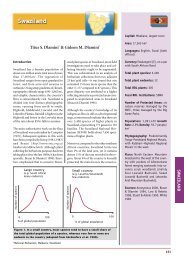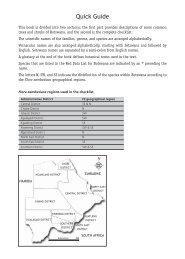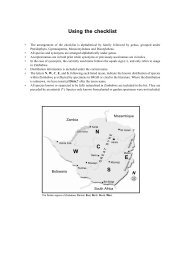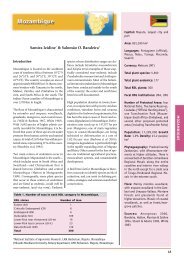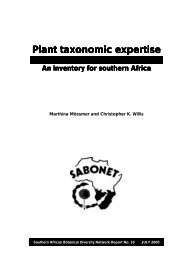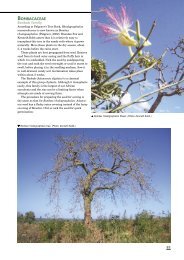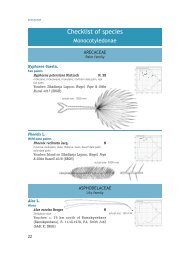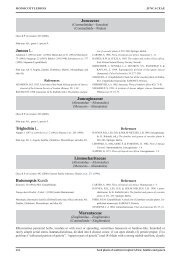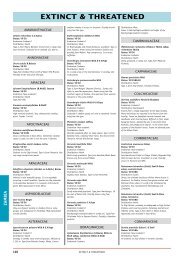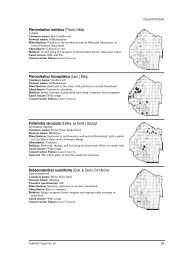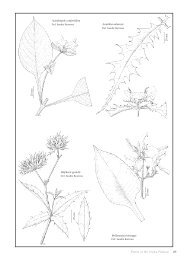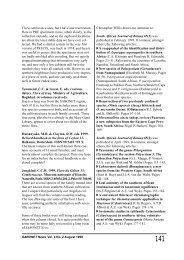266-299 - SABONET
266-299 - SABONET
266-299 - SABONET
Create successful ePaper yourself
Turn your PDF publications into a flip-book with our unique Google optimized e-Paper software.
Malawi. Nyika National Park, without locality or collecting details (Mill<br />
1979); Mwanda Mt., 2000, Winter 4159 (MAL).<br />
Lippia javanica (Burm.f.) Spreng.<br />
Lippia whytei Mold.<br />
Chichewa: chanzi, vumba; Yao: chisunganjeu, mchenjema<br />
Shrub to 4 m tall, softly woody; leaves strongly aromatic and slightly unpleasant,<br />
opposite or in whorls of 3, 10–100 x 3–45 mm, scabrid and<br />
rugulose (rough) above, serrulate; flowers in a small compact spike, white<br />
to yellowish green; in woodland, scrubby grassland, rocky hillsides; 450–<br />
2,350 m. Widespread in Africa, from South Africa to Angola and Ethiopia.<br />
Not in Asia, despite the species name, which was applied erroneously.<br />
Source. F.T.E.A. Verbenaceae: 30 (1992).<br />
Malawi. Nyika National Park, without locality or collecting details (Mill<br />
1979).<br />
Lippia plicata Baker <br />
Lippia strobiliformis Mold.<br />
Woody herb or shrub 0.6–3 m, stems square, brown to reddish purple;<br />
leaves aromatic (minty), opposite, rarely in threes, ovate to lanceolate, 15–<br />
100 x 7–55 mm, harshly scabrid above, margins crenate-serrate; flowers in<br />
Rinorea convallarioides (Baker f.) Eyles <br />
Understorey shrub or small tree 1.5–7 m tall; leaves simple, alternate, oblong-elliptic,<br />
40–70 x 15–40 mm, sharply serrate or subentire, hairless except<br />
on main veins, petiole 2–4 mm long, channelled above, stipules 3–<br />
4 mm long; flowers axillary; fruit a 3-sided capsule to 13 mm long; in evergreen<br />
forest; only in submontane forest (below 2,000 m) on the eastern<br />
escarpment, but not recorded by Dowsett-Lemaire (1985). Zimbabwe,<br />
Mozambique, and Malawi.<br />
Source. Chapman & White (1970: 126).<br />
Malawi. Nyika Plateau, “eastern escarpment Forests”, no specimen located.<br />
Viscum combreticola Engl. <br />
Relatively large dioecious leafless parasitic shrubs, more or less pendulous<br />
with age, yellowish green, stems flattened and strongly ribbed, but round<br />
with age; berries stalkless, more or less round, 6–7 mm long, warty when<br />
young, almost smooth at maturity, orange; a parasite of various hosts,<br />
but commonly on Combretum and various legumes, including<br />
Brachystegia. Widespread from D.R.C. and Kenya to Angola and South<br />
Africa.<br />
Source. Mill (1979); Polhill & Wiens (1998: 303).<br />
Malawi. Nyika National Park, Chisanga Falls, 1,800 m, 1982, Dowsett-<br />
Lemaire 307 (K); Chisanga Falls, 1,800 m, 1986, R.M. Polhill & D. Polhill<br />
5254 (K, MAL).<br />
Viscum cylindricum Polhill & Wiens.<br />
Leafless, dioecious, parasitic shrub with pendulous branches up to 1–2 m<br />
long, distal branches flattened, 2–4 mm broad; flowers sessile, single, style<br />
indistinct, stigma on elevated mound above tepal scars, berries sessile, oblong,<br />
7–3.5 mm; in forest and high-rainfall Brachystegia woodland on various<br />
hosts. Only known from Malawi.<br />
Source. Polhill & Wiens (1998: 303); Polhill (2001: 593, fig. 211G).<br />
Malawi. Nyika Plateau, 7 km W. of Chelinda, 1972, Wiens 4614 (K, UT);<br />
Nyika National Park, 6.5 km W. of Livingstonia junction, Nya Mkowa,<br />
2,000 m, 1978, Pawek 13846 (BR, K, MAL, MO, WAG).<br />
Viscum goetzei Engl.<br />
Leafless dioecious parasite with flattened stems narrowing to the nodes;<br />
berries with a 1 mm long stalk, 3 mm long, smooth, orange; a parasite<br />
(epiparasite) of Loranthaceae, in evergreen forests to 2,350 m. Southern<br />
Highlands of Tanzania, Nyika Plateau, and Eastern Highlands of Zimbabwe.<br />
Source. Polhill & Wiens (1998: 302); Polhill (2001: 593, fig. 211J, K).<br />
VIOLACEAE<br />
VISCACEAE<br />
roundish terminal clusters, white/yellow to pink or lilac, scented; in grassland<br />
and various types of woodland, often in disturbed areas; 450–1,950 m.<br />
Mozambique, Malawi, Zambia, Angola, D.R.C., and Tanzania.<br />
Source. Brummitt (1973); F.T.E.A. Verbenaceae: 34 (1992).<br />
Malawi. Nyika National Park, N.W. foot of Nganda, 1972, Brummitt &<br />
Synge 47 (K, MAL, SRGH, FHO, LISC); W. of Vitinthiza Hill, 2000, Salubeni<br />
& Mwanyambo 6763 & 6806 (MAL).<br />
Lippia woodii Mold.<br />
Lippia africana Mold. var. villosa Mold.; Lippia wilmsii Pearson var.<br />
villosa (Mold.) Mold.<br />
Herb or shrublet 150–600 mm tall, with several unbranched stems; leaves<br />
strongly aromatic, opposite, obovate-elliptic to rhomboid, 10–80 x 10–<br />
30 mm, shallowly crenulate, rugose/bullate, silvery hairy below, sparsely<br />
hairy above; flowers in axillary clusters, white, green or yellow, usually<br />
with an orange centre; in open woodland or grassland subjected to frequent<br />
burning; 1,110–2,280 m. Zimbabwe and Mozambique northwards<br />
to Uganda.<br />
Source. F.T.E.A. Verbenaceae: 33 (1992).<br />
Malawi. Nyika National Park, without locality or collecting details (Mill<br />
1979).<br />
Viola abyssinica Steud. ex Oliv. <br />
Chichewa: katongolola<br />
Perennial herb, stems to 600 mm long, trailing or creeping, rooting at nodes,<br />
angular or winged; leaves broadly ovate to roundish, base cordate, margins<br />
crenate-dentate; flowers single, axillary, on pedicels 10–40 mm long,<br />
white to bluish or violet; in moist grassland, moist areas in forest or forest<br />
margins; 1,200–2,520 m. Widespread in the mountains of tropical Africa.<br />
Source. Flora zambesiaca 1(1): 258 (1960).<br />
Malawi. Nyika National Park, without locality, 1946, Brass 17323 (BM, K,<br />
PRE, SRGH); Mpopoti, 2000, Mwanyambo 542 (MAL).<br />
Zambia. Nyika Plateau, near Rest House, 1958, Robson 395 (BM, K, SRGH).<br />
Malawi. Nyika National Park, vicinity of Juniper Forest, 2,190 m, 1972,<br />
Wiens 4612 (K, MO, P).<br />
Viscum loranthicola Polhill & Wiens<br />
Small, leafless, densely branched parasitic shrub, distal internodes rounded<br />
to slightly flattened; flowers sessile, male flowers with anthers fused together;<br />
berries orange, sessile, round, smooth, 3 mm diameter; epiparasite<br />
on several genera of Loranthaceae. Burundi, Tanzania, Zambia, and northern<br />
Malawi.<br />
Source. Polhill & Wiens (1998: 297);<br />
Malawi. Rumphi-Chisenga Road, half a km S. of Nyika Road junction,<br />
1,500 m, 1972, Wiens 4607 (K, MAL, MO, UT); 16 km E. of Barrier, 1,650 m,<br />
1976, Phillips 1338 (K, MO, SRGH, WAG).<br />
Viscum shirense Sprague<br />
Viscum junodii Engl., nom. nud.<br />
Leafless dioecious parasite, pendulous with age, stems flattened; berries<br />
with a stalk of 1–1.5 mm, round to ellipsoid, 3–5 mm long, smooth, orange;<br />
a parasite of various hosts, commonly on Bridelia, in high rainfall<br />
woodland, riverine forest, and on margins of montane forest; up to 1,700 m.<br />
D.R.C., Tanzania, Malawi, Mozambique, Zambia, and Zimbabwe. The<br />
citations given below might be misidentifications for allied species, but V.<br />
shirense is certainly recorded from near Chisenga on the Chambo R. and<br />
around Wenya. Furthermore, the closely similar V. congdonii Polhill &<br />
Wiens, known from Jembya Forest Reserve, is likely to occur. Differences<br />
are given in the sources cited above.<br />
Source. Polhill & Wiens (1998: 306); Polhill (2001: 595).<br />
Malawi. Nyika National Park, Kasyaula & Zovochipolo Forests (Dowsett-<br />
Lemaire 1985).<br />
Zambia. Nyika National Park, Manyenjere, Kasoma & Chowo Forests<br />
(Dowsett-Lemaire 1985).<br />
Plants of the Nyika Plateau<br />
283<br />
VISCACEAE



